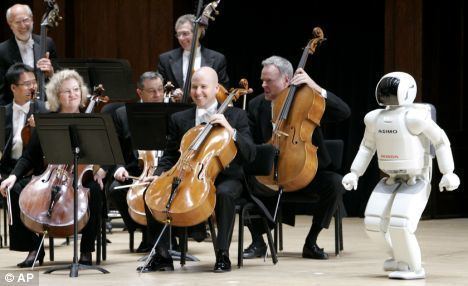ASIMO conducts the Detroit Symphony Orchestra.
On May 13, 2008, the Detroit Symphony Orchestra welcomed a very special guest conductor as part of the Power of Dreams Music Education Fund initiative. Unlike other guest conductors, this one didnt have an illustrious background in music. Nor was the conductor a well-known celebrity. In fact, the conductor did
nt even have a heartbeat! It was the Advanced Step in Innovative Mobility robot, better known as ASIMO.
A creation from the robotics division of Honda, ASIMO is a humanoid robot a robot that resembles a human being capable of accomplishing tasks that most robots find very challenging. That includes everything from climbing up and down a set of stairs to running in a circle to maneuvering through a room filled with obstacles. ASIMO has the capability to move in a smooth and fluid way with one motion flowing into the next. But while overcoming challenges and moving smoothly is impressive, its not on the same level as conducting an orchestra.
There seems to be an inherent disconnect between robotics and music. For many people, music has an emotional component. Whether its a musician expressing sorrow by playing a mournful requiem or a group of children bouncing along to a chipper tune, music and mood seem to go hand-in-hand. But ASIMO cant experience emotions or moods. As a robot, ASIMO can only receive input and make calculations or respond to commands given by an operator.
A good conductor can influence the mood of a piece of music by cueing musicians with gestures, facial expressions and even inhaling sharply. The relationship between the musicians and the conductor is an important aspect of any performance. But what happens when the conductor isnt even a human being?
TO RUN WHERE THEBRAVE DARE NOT GO
ASIMO conducted the Detroit Symphony Orchestra in a performance of the song "The Impossible Dream" from the musical "The Man of La Mancha" by Mitch Leigh and Joe Darion. After the performance, famed cellist Yo-Yo Ma joined the robot on stage and shook its hand.
Hondas Asimo conductsDetroit Symphony Orchestra
Limitations of Robotic Conductors
While ASIMO is an example of advanced technology and innovation, its not quite at the level where it can pick up a baton and lead an orchestra without preparation. In fact, the only way the robot can conduct an orchestra is to follow a complex set of instructions programmed by engineers. To lead the Detroit Symphony Orchestra, ASIMO had to take an intense crash course in movement.
First, engineers from Honda met with Charles Burke. Burke is the education director for the Detroit Symphony. The engineers watched Burke as he conducted "The Impossible Dream" to a pianist. They had to pay close attention, because Burkes motions would serve as the model ASIMO would follow six months later at the Power of Dreams event.
Then the engineers set to work. They studied Burkes movements and programmed ASIMO to follow the same patterns. ASIMOs complex system of joints and motors allowed it to mimic Burkes range of motion with mechanical precision.
While ASIMOs performance was impressive some musicians remarked that its movements were almost human it wasnt interactive. The orchestras musicians would have had a similar experience if they had followed a pre-recorded human conductor. There was no opportunity for improvisation.
Some people might argue that ASIMO didnt really direct the Detroit Symphony Orchestra rather, Burke did. After all, ASIMO was really recreating Burkes style and movements. The entire routine was simply a program running on ASIMOs operating system. The robot just ran through the series of motions from start to finish, and would have continued regardless of whether or not the orchestra followed the robots lead.

In a way, that makes ASIMO a very expensive metronome a tempo-keeping device used in musical performances. The robot could keep time with incredible precision. Since most music in part relies on maintaining a particular rhythm, this was a useful skill. But it also restricted the amount of emotion that could come through the piece. While ASIMO could change tempo during a performance, engineers had to pre-program the specific shifts in tempo in advance. In other words, ASIMO would always change tempo the same way at the same point in a piece.
Will robots ever be able to conduct an orchestra the way a human conductor can? That will depend on a number of factors. First, robots will need some measure of artificial intelligence in order to be able to interpret a performance and make decisions based on that information. Robots will also have to be able to express intentions to musicians and recognize the musicians responses in return. In other words, we have a long way to go before we see the Terminator direct the London Philharmonic in a performance of "Night on Bald Mountain."
BY YOUR COMMAND
Without direct human control, ASIMO just follows its programming. ASIMOs limitations became painfully clear during the rehearsal process. At the first rehearsal, the robots tempo slowed slightly without warning. Musicians became lost and the piece fell apart. ASIMO remained blissfully unaware of the problem [source: ABC News].
.jpg)